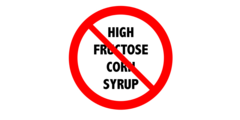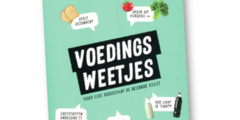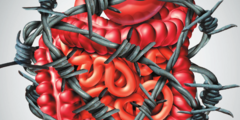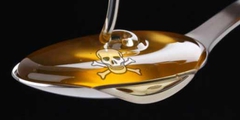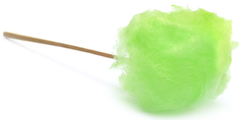
We zeggen altijd dat suiker ongezond is en dat we er te veel van eten. Impliciet bedoelen we dan de groep van toegevoegde suikers in bewerkte voeding. Maar wat met honing, dat op het eerste gezicht vooral uit suiker bestaat? Feit is dat honing anders in elkaar zit dan andere suikerproducten en dat ze andere eigenschappen heeft.
Beste bezoeker, u heeft geen toegang.
Enkel (web)abonnees hebben toegang tot tijdschriftartikelen. Het webabonnement is nog in de maak.
U kunt zich wel alvast (gratis) registreren en tal van andere webartikelen raadplegen!
Auteur
Verschenen in
Referenties
Sugar intake and risk
1. RIVM. Voedselconsumptiepeiling (VCP) 2012-2016. Suiker, toegevoegd. Accessed 05-03-2023
https://www.wateetnederland.nl/onderwerpen/suiker
1a. Walton J, Bell H, Re R, Nugent AP. Current perspectives on global sugar consumption: definitions, recommendations, population intakes, challenges and future direction. Nutr Res Rev. 2021 Aug 9:1-22. doi: 10.1017/S095442242100024X. Epub ahead of print. PMID: 34369326.
https://pubmed.ncbi.nlm.nih.gov/34369326/
2. Australian Health Survey: Consumption of added sugars, 2011-12, Released at 11:30 AM (CANBERRA TIME) 27/04/2016; accessed 05-03-2023
https://www.abs.gov.au/ausstats/abs@.nsf/Lookup/4364.0.55.011main+features12011-12#:~:text=In%202011%2D12%2C%20Australians%20consumed,from%20honey%20and%20fruit%20juice.
2a. Mann J. Free sugars and human health: sufficient evidence for action? Lancet. 2004 Mar 27;363(9414):1068-70. doi: 10.1016/S0140-6736(04)15844-3. PMID: 15051288.
https://pubmed.ncbi.nlm.nih.gov/15051288/
2b. Te Morenga LA, Howatson AJ, Jones RM, Mann J. Dietary sugars and cardiometabolic risk: systematic review and meta-analyses of randomized controlled trials of the effects on blood pressure and lipids. Am J Clin Nutr. 2014 Jul;100(1):65-79. doi: 10.3945/ajcn.113.081521. Epub 2014 May 7. PMID: 24808490.
https://pubmed.ncbi.nlm.nih.gov/24808490/
2c. Gill JM, Sattar N. Fruit juice: just another sugary drink? Lancet Diabetes Endocrinol. 2014 Jun;2(6):444-6. doi: 10.1016/S2213-8587(14)70013-0. Epub 2014 Feb 10. PMID: 24731678.
https://pubmed.ncbi.nlm.nih.gov/24731678/
2d. Yin J, Zhu Y, Malik V, Li X, Peng X, Zhang FF, Shan Z, Liu L. Intake of Sugar-Sweetened and Low-Calorie Sweetened Beverages and Risk of Cardiovascular Disease: A Meta-Analysis and Systematic Review. Adv Nutr. 2021 Feb 1;12(1):89-101. doi: 10.1093/advances/nmaa084. PMID: 32696948; PMCID: PMC7850046.
https://pubmed.ncbi.nlm.nih.gov/32696948/
2e.Malik VS, Hu FB. The role of sugar-sweetened beverages in the global epidemics of obesity and chronic diseases. Nat Rev Endocrinol. 2022 Apr;18(4):205-218. doi: 10.1038/s41574-021-00627-6. Epub 2022 Jan 21. PMID: 35064240; PMCID: PMC8778490.
https://pubmed.ncbi.nlm.nih.gov/35064240/
Sugar recommendations
3. Global Health and Pharma. 5 Year-Olds Eat and Drink Their Body Weight in Sugar Each Year. Posted on June 28, 2016, Accessed 05-03-2023
https://www.ghp-news.com/2016-5-year-olds-eat-and-drink-their-body-weigh...
3a. Gander K. Children aged five eat their bodyweight in sugar, experts warn. The Independent, Monday 04 January 2016 10:24, accessed 05-03-2023
https://www.independent.co.uk/life-style/health-and-families/health-news...
4. Guideline: Sugars Intake for Adults and Children. Geneva: World Health Organization; 2015. PMID: 25905159.
https://pubmed.ncbi.nlm.nih.gov/25905159/
https://www.ncbi.nlm.nih.gov/books/NBK285537/
https://apps.who.int/iris/bitstream/handle/10665/149782/9789241549028_en...
5. EFSA NDA Panel, 2022. Scientific Opinion on the Tolerable Upper Intake Level for dietary sugars (EFSA-Q-2016-00414). EFSA Journal 2022;20(2):7074. doi:10.2903/j.efsa.2022.7074 © 2022 European Food Safety Authority. EFSA Journal published by John Wiley and Sons Ltd on behalf of European Food Safety Authority.
https://www.efsa.europa.eu/sites/default/files/2022-02/Annex-PLS-Sugars.pdf
6. EFSA Panel on Nutrition, Novel Foods and Food Allergens (NDA), Turck, D., Bohn, T., Castenmiller, J., de Henauw, S., Hirsch‐Ernst, K. I., ... & Vinceti, M. (2022). Tolerable upper intake level for dietary sugars. EFSA Journal, 20(2), e07074.
https://efsa.onlinelibrary.wiley.com/doi/full/10.2903/j.efsa.2022.7074
Honey and Royal Jelly
7. Miller DM, Jamison K, Wallace RE. 4-H Honey Bee Leaders Guide Book I, The Buzz About Bees: Honey Bee Biology and Behavior. Virginia Tech. Publication 380-071, 2014. Accessed 05-03-2023
https://vtechworks.lib.vt.edu/bitstream/handle/10919/56147/380-071.pdf?s...
8. Barbara Taliaferro FACTS ABOUT THE NURSE HONEY BEE, accessed 05-03-2023
https://animals.mom.com/nurse-honey-bee-4956.html
9. Riddle S. The chemistry of honey. Bee Culture. The magazine of American Beekeeping, July 25, 2016. Accessed 05-03-2016.
https://www.beeculture.com/the-chemistry-of-honey/
10. Praktijkonderzoek Plant en Omgeving, Wageningen UR. Wat eet een honingbij? Accessed 05-03-2016
11. Schotanus A. Het voedsel van bijen deel 1. Maandblad van de Koninklijke Vlaamse Imkersbond, 2033
https://konvib.be/?page_id=2254
12. Chittka A, Chittka L. Epigenetics of royalty. PLoS Biol. 2010 Nov 2;8(11):e1000532. doi: 10.1371/journal.pbio.1000532. PMID: 21072243; PMCID: PMC2970563.
https://pubmed.ncbi.nlm.nih.gov/21072243/
Honey and health
13. Ahmed A, Tul-Noor Z, Lee D, Bajwah S, Ahmed Z, Zafar S, Syeda M, Jamil F, Qureshi F, Zia F, Baig R, Ahmed S, Tayyiba M, Ahmad S, Ramdath D, Tsao R, Cui S, Kendall CWC, de Souza RJ, Khan TA, Sievenpiper JL. Effect of honey on cardiometabolic risk factors: a systematic review and meta-analysis. Nutr Rev. 2022 Nov 16:nuac086. doi: 10.1093/nutrit/nuac086. Epub ahead of print. PMID: 36379223.
https://pubmed.ncbi.nlm.nih.gov/36379223/
14. Oldfield J. Sweet: Honey Reduces Cardiometabolic Risks, U of T Study Shows. University of Toronto. Nov 16, 2022, accessed 05-03-2023
https://nutrisci.med.utoronto.ca/news/sweet-honey-reduces-cardiometaboli...
15. Bogdanov S, Jurendic T, Sieber R, Gallmann P. Honey for nutrition and health: a review. J Am Coll Nutr. 2008 Dec;27(6):677-89. doi: 10.1080/07315724.2008.10719745. PMID: 19155427.
https://pubmed.ncbi.nlm.nih.gov/19155427/
16. Samarghandian S, Farkhondeh T, Samini F. Honey and Health: A Review of Recent Clinical Research. Pharmacognosy Res. 2017 Apr-Jun;9(2):121-127. doi: 10.4103/0974-8490.204647. PMID: 28539734; PMCID: PMC5424551.
https://pubmed.ncbi.nlm.nih.gov/28539734/
17. Eteraf-Oskouei T, Najafi M. Traditional and modern uses of natural honey in human diseases: a review. Iran J Basic Med Sci. 2013 Jun;16(6):731-42. PMID: 23997898; PMCID: PMC3758027.
https://pubmed.ncbi.nlm.nih.gov/23997898/
18. Alvarez-Suarez JM, Giampieri F, Battino M. Honey as a source of dietary antioxidants: structures, bioavailability and evidence of protective effects against human chronic diseases. Curr Med Chem. 2013;20(5):621-38. doi: 10.2174/092986713804999358. PMID: 23298140.
https://pubmed.ncbi.nlm.nih.gov/23298140/
19. Deibert P, König D, Kloock B, Groenefeld M, Berg A. Glycaemic and insulinaemic properties of some German honey varieties. Eur J Clin Nutr. 2010 Jul;64(7):762-4. doi: 10.1038/ejcn.2009.103. Epub 2009 Sep 16. PMID: 19756024.
https://pubmed.ncbi.nlm.nih.gov/19756024/
20. Zulkifli NA, Hassan Z, Mustafa MZ, Azman WNW, Hadie SNH, Ghani N, Mat Zin AA. The potential neuroprotective effects of stingless bee honey. Front Aging Neurosci. 2023 Feb 8;14:1048028. doi: 10.3389/fnagi.2022.1048028. PMID: 36846103; PMCID: PMC9945235.
https://pubmed.ncbi.nlm.nih.gov/36846103/
21. Marlowe FW, Berbesque JC, Wood B, Crittenden A, Porter C, Mabulla A. Honey, Hadza, hunter-gatherers, and human evolution. J Hum Evol. 2014 Jun;71:119-28. doi: 10.1016/j.jhevol.2014.03.006. Epub 2014 Apr 17. PMID: 24746602.
https://pubmed.ncbi.nlm.nih.gov/24746602/
22. Murray, S. S., Schoeninger, M. J., Bunn, H. T., Pickering, T. R., & Marlett, J. A. (2001). Nutritional composition of some wild plant foods and honey used by Hadza foragers of Tanzania. Journal of food composition and analysis, 14(1), 3-13.
https://www.sciencedirect.com/science/article/abs/pii/S0889157500909608
23. Pontzer H, Wood BM, Raichlen DA. Hunter-gatherers as models in public health. Obes Rev. 2018 Dec;19 Suppl 1:24-35. doi: 10.1111/obr.12785. PMID: 30511505.
https://pubmed.ncbi.nlm.nih.gov/30511505/
24. Khan SU, Anjum SI, Rahman K, Ansari MJ, Khan WU, Kamal S, Khattak B, Muhammad A, Khan HU. Honey: Single food stuff comprises many drugs. Saudi J Biol Sci. 2018 Feb;25(2):320-325. doi: 10.1016/j.sjbs.2017.08.004. Epub 2017 Aug 16. PMID: 29472785; PMCID: PMC5815988.
https://pubmed.ncbi.nlm.nih.gov/29472785/
25. Pasupuleti VR, Sammugam L, Ramesh N, Gan SH. Honey, Propolis, and Royal Jelly: A Comprehensive Review of Their Biological Actions and Health Benefits. Oxid Med Cell Longev. 2017;2017:1259510. doi: 10.1155/2017/1259510. Epub 2017 Jul 26. PMID: 28814983; PMCID: PMC5549483.
https://pubmed.ncbi.nlm.nih.gov/28814983/
Honey as synbiotic: prebiotic plus probiotic
26. Xiong ZR, Sogin JH, Worobo RW. Microbiome analysis of raw honey reveals important factors influencing the bacterial and fungal communities. Front Microbiol. 2023 Jan 12;13:1099522. doi: 10.3389/fmicb.2022.1099522. PMID: 36713191; PMCID: PMC9877413.
https://pubmed.ncbi.nlm.nih.gov/36713191/
26a. Dahiya, D., & Nigam, P. S. (2022). Probiotics, prebiotics, synbiotics, and fermented foods as potential biotics in nutrition improving health via microbiome-gut-brain axis. Fermentation, 8(7), 303.
https://www.mdpi.com/2311-5637/8/7/303
27. Alaerjani WMA, Abu-Melha S, Alshareef RMH, Al-Farhan BS, Ghramh HA, Al-Shehri BMA, Bajaber MA, Khan KA, Alrooqi MM, Modawe GA, Mohammed MEA. Biochemical Reactions and Their Biological Contributions in Honey. Molecules. 2022 Jul 23;27(15):4719. doi: 10.3390/molecules27154719. PMID: 35897895; PMCID: PMC9331712.
https://pubmed.ncbi.nlm.nih.gov/35897895/
28. Landry, B. K. U., Moumita, S., Jayabalan, R., & Francois, Z. N. (2016). Honey, Probiotics and Prebiotics. Research Journal of Pharmaceutical Biological and Chemical Sciences, 7(5), 2428-2438.
https://www.researchgate.net/publication/307971200_Honey_Probiotics_and_...
29. Gaifullina, L. R., Saltykova, E. S., & Nikolenko, A. G. (2016). Prebiotic and probiotic properties of honey. In Honey: Geographical Origins, Bioactive Properties and Health Benefits (pp. 53-79).
https://www.researchgate.net/profile/L-Gaifullina-2/publication/31858593...
30. Gaifullina L.R., Saltykova E.S., Nikolenko A.G. Honey as a synbiotic food product. Biomics 2017 no 9, 12-23.
https://biomicsj.ru/upload/iblock/4b7/3.pdf
31. Abdelsamad NO, Esawy MA, Mahmoud ZE, El-Shazly AI, Elsayed TR, Gamal AA. Evaluation of different bacterial honey isolates as probiotics and their efficient roles in cholesterol reduction. World J Microbiol Biotechnol. 2022 May 4;38(6):106. doi: 10.1007/s11274-022-03259-8. PMID: 35507200; PMCID: PMC9068672.
https://pubmed.ncbi.nlm.nih.gov/35507200/
32. Schell KR, Fernandes KE, Shanahan E, Wilson I, Blair SE, Carter DA, Cokcetin NN. The Potential of Honey as a Prebiotic Food to Re-engineer the Gut Microbiome Toward a Healthy State. Front Nutr. 2022 Jul 28;9:957932. doi: 10.3389/fnut.2022.957932. PMID: 35967810; PMCID: PMC9367972.
https://www.ncbi.nlm.nih.gov/pmc/articles/PMC9367972/
33. Mustar S, Ibrahim N. A Sweeter Pill to Swallow: A Review of Honey Bees and Honey as a Source of Probiotic and Prebiotic Products. Foods. 2022 Jul 15;11(14):2102. doi: 10.3390/foods11142102. PMID: 35885345; PMCID: PMC9324438.

